Low Noise Opto-Electro-Mechanical Modulator for RF-to-Optical Transduction in Quantum Communications
Abstract
1. Introduction
2. Design Strategy of the OEMM
3. Fabrication of the OEMM Module
3.1. The Opto-Electro-Mechanical Resonating Part
3.2. Microfabricated Coupling Capacitor
3.3. OEMM Assembly Procedure
4. Characterization
4.1. Modal Analysis of the OEMMs
4.2. Electro–Mechanical Characterization of OEMM Device
5. Discussion and Future Perspectives
Author Contributions
Funding
Institutional Review Board Statement
Data Availability Statement
Acknowledgments
Conflicts of Interest
Abbreviations
| OEMM | Opto-Electro-Mechanical-Modulator |
| FEM | Finite Element Method |
References
- Chu, Y.; Gröblacher, S. A perspective on hybrid quantum opto- and electromechanical systems. Appl. Phys. Lett. 2020, 117, 150503. [Google Scholar] [CrossRef]
- Lauk, N.; Sinclair, N.; Barzanjeh, S.; Covey, J.P.; Saffman, M.; Spiropulu, M.; Simon, C. Perspectives on quantum transduction. Quantum Sci. Technol. 2020, 5, 020501. [Google Scholar] [CrossRef]
- Kimble, H.J. The quantum Internet. Nature 2008, 453, 1023–1030. [Google Scholar] [CrossRef]
- Pirandola, S.; Bardhan, B.R.; Gehring, T.; Weedbrook, C.; Lloyd, S. Advances in photonic quantum sensing. Nat. Photon. 2018, 12, 724–733. [Google Scholar] [CrossRef]
- Bagci, T.; Simonsen, A.; Schmid, S.; Villanueva, L.G.; Zeuthen, E.; Appel, J.; Taylor, J.M.; Sørensen, A.; Usami, K.; Schliesser, A.; et al. Optical detection of radio waves through a nanomechanical transducer. Nature 2014, 507, 81–85. [Google Scholar] [CrossRef] [PubMed]
- Takeda, K.; Nagasaka, K.; Noguchi, A.; Yamazaki, R.; Nakamura, Y.; Iwase, E.; Taylor, J.M.; Usami, K. Electro-mechano-optical detection of nuclear magnetic resonance. Optica 2018, 5, 152–158. [Google Scholar] [CrossRef]
- Moaddel Haghighi, I.; Malossi, N.; Natali, R.; Di Giuseppe, G.; Vitali, D. Sensitivity-Bandwidth Limit in a Multimode Optoelectromechanical Transducer. Phys. Rev. Appl. 2018, 9, 034031. [Google Scholar] [CrossRef]
- Simonsen, A.; Saarinen, S.A.; Sánchez-Heredia, J.D.; Ardenkjær-Larsen, J.H.; Schliesser, A.; Polzik, E.S. Sensitive optomechanical transduction of electric and magnetic signals to the optical domain. Opt. Express 2019, 27, 18561. [Google Scholar] [CrossRef]
- Simonsen, A.; Sánchez-Heredia, J.D.; Saarinen, S.A.; Ardenkjær-Larsen, J.H.; Schliesser, A.; Polzik, E.S. Magnetic resonance imaging with optical preamplication and detection. Sci. Rep. 2019, 9, 18173. [Google Scholar] [CrossRef]
- Wang, Y.-D.; Clerk, A.A. Using Interference for High Fidelity Quantum State Transfer in Optomechanics. Phys. Rev. Lett. 2012, 108, 153603. [Google Scholar] [CrossRef]
- Tian, L. Adiabatic State Conversion and Pulse Transmission in Optomechanical Systems. Phys. Rev. Lett. 2012, 108, 153604. [Google Scholar] [CrossRef] [PubMed]
- Barzanjeh, S.; Abdi, M.; Milburn, G.J.; Tombesi, P.; Vitali, D. Reversible Optical-to-Microwave Quantum Interface. Phys. Rev. Lett. 2012, 109, 130503. [Google Scholar] [CrossRef] [PubMed]
- Hill, J.T.; Safavi-Naeini, A.H.; Chan, J.; Painter, O. Coherent optical wavelength conversion via cavity optomechanics. Nat. Commun. 2010, 3, 1196. [Google Scholar] [CrossRef]
- Andrews, R.W.; Peterson, R.W.; Purdy, T.P.; Cicak, K.; Simmonds, R.W.; Regal, C.A.; Lehnert, K.W. Bidirectional and efficient conversion between microwave and optical light. Nat. Phys. 2014, 10, 321–326. [Google Scholar] [CrossRef]
- Higginbotham, A.P.; Burns, P.S.; Urmey, M.D.; Peterson, R.W.; Kampel, N.S.; Brubaker, B.M.; Smith, G.; Lehnert, K.W.; Regal, C.A. Harnessing electro-optic correlations in an efficient mechanical converter. Nat. Phys. 2018, 14, 1038–1042. [Google Scholar] [CrossRef]
- Malossi, N.; Piergentili, P.; Li, J.; Serra, E.; Natali, R.; Di Giuseppe, G.; Vitali, D. Sympathetic cooling of a radio-frequency LC circuit to its ground state in an optoelectromechanical system. Phys. Rev. A 2021, 103, 033516. [Google Scholar] [CrossRef]
- Brubaker, B.M.; Kindem, J.M.; Urmey, M.D.; Mittal, S.; Delaney, R.D.; Burns, P.S.; Vissers, M.R.; Lehnert, K.W.; Regal, C.A. Optomechanical ground-state cooling in a continuous and efficient electro-optic transducer. Phys. Rev. X 2022, 12, 021062. [Google Scholar] [CrossRef]
- Hafezi, M.; Kim, Z.; Rolston, S.L.; Orozco, L.A.; Lev, B.L.; Taylor, J.M. Atomic interface between microwave and optical photons. Phys. Rev. A 2012, 85, 020302. [Google Scholar] [CrossRef]
- Petrosyan, D.; Mølmer, K.; Fortágh, J.; Saffman, M. Microwave to optical conversion with atoms on a superconducting chip. New J. Phys. 2019, 21, 073033. [Google Scholar] [CrossRef]
- Tu, H.-T.; Liao, K.-Y.; Zhang, Z.-X.; Liu, X.-H.; Zheng, S.-Y.; Yang, S.-Z.; Zhang, X.-D.; Yan, H.; Zhu, S.-L. High-efficiency coherent microwave-to-optics conversion via off-resonant scattering. Nat. Photon. 2022, 16, 291–296. [Google Scholar] [CrossRef]
- Kumar, A.; Suleymanzade, A.; Stone, M.; Taneja, L.; Anferov, A.; Schuster, D.I.; Simon, J. Quantum-enabled millimetre wave to optical transduction using neutral atoms. Nature 2023, 615, 614–619. [Google Scholar] [CrossRef]
- Tsang, M. Cavity quantum electro-optics. Phys. Rev. A 2010, 81, 063837. [Google Scholar] [CrossRef]
- Rueda, A.; Hease, W.; Barzanjeh, S.; Fink, J.M. Electro-optic entanglement source for microwave to telecom quantum state transfer. Npj Quantum Inf. 2019, 5, 108. [Google Scholar] [CrossRef]
- McKenna, T.P.; Witmer, J.D.; Patel, R.N.; Jiang, W.; Van Laer, R.; Arrangoiz-Arriola, P.; Wollack, E.A.; Herrmann, J.F.; Safavi-Naeini, A.H. Cryogenic microwave-to-optical conversion using a triply resonant lithium-niobate-on-sapphire transducer. Optica 2020, 7, 1737–1745. [Google Scholar] [CrossRef]
- Hease, W.; Rueda, A.; Sahu, R.; Wulf, M.; Arnold, G.; Schwefel, H.G.L.; Fink, J.M. Bidirectional Electro-Optic Wavelength Conversion in the Quantum Ground State. PRX Quantum 2020, 1, 020315. [Google Scholar] [CrossRef]
- Sahu, R.; Hease, W.; Rueda, A.; Arnold, G.; Qiu, L.; Fink, J.M. Quantum-enabled operation of a microwave-optical interface. Nat. Commun. 2022, 13, 1276. [Google Scholar] [CrossRef]
- Sahu, R.; Qiu, L.; Hease, W.; Arnold, G.; Minoguchi, Y.; Rabl, P.; Fink, J.M. Entangling microwaves with light. Science 2023, 380, 718–721. [Google Scholar] [CrossRef]
- Hisatomi, R.; Osada, A.; Tabuchi, Y.; Ishikawa, T.; Noguchi, A.; Yamazaki, R.; Usami, K.; Nakamura, Y. Bidirectional conversion between microwave and light via ferromagnetic magnons. Phys. Rev. B 2016, 93, 174427. [Google Scholar] [CrossRef]
- Vainsencher, A.; Satzinger, K.J.; Peairs, G.A.; Cleland, A.N. Bi-directional conversion between microwave and optical frequencies in a piezoelectric optomechanical device. Appl. Phys. Lett. 2016, 109, 033107. [Google Scholar] [CrossRef]
- Balram, K.C.; Davanco, M.I.; Song, J.D.; Srinivasan, K. Coherent coupling between radiofrequency, optical and acoustic waves in piezo-optomechanical circuits. Nat. Photon. 2016, 10, 346–352. [Google Scholar] [CrossRef]
- Schneider, K.; Baumgartner, Y.; Hönl, S.; Welter, P.; Hahn, H.; Wilson, D.J.; Czornomaz, L.; Seidler, P. Optomechanics with one-dimensional gallium phosphide photonic crystal cavities. Optica 2019, 6, 577–584. [Google Scholar] [CrossRef]
- Stockill, R.; Forsch, M.; Hijazi, F.; Beaudoin, G.; Pantzas, K.; Sagnes, I.; Braive, R.; Gröblacher, S. Ultra-low-noise Microwave to Optics Conversion in Gallium Phosphide. Nat. Commun. 2022, 13, 6583. [Google Scholar] [CrossRef] [PubMed]
- Jiang, W.; Patel, R.N.; Mayor, F.M.; McKenna, T.P.; Arrangoiz-Arriola, P.; Sarabalis, C.J.; Witmer, J.D.; Laer, R.V.; Safavi-Naeini, A.H. Lithium niobate piezo-optomechanical crystals. Optica 2019, 6, 845–853. [Google Scholar] [CrossRef]
- Shao, L.; Yu, M.; Maity, S.; Sinclair, N.; Zheng, L.; Chia, C.; Shams-Ansari, A.; Wang, C.; Zhang, M.; Lai, K.; et al. Microwave-to-optical conversion using lithium niobate thin-film acoustic resonators. Optica 2019, 6, 1498–1505. [Google Scholar] [CrossRef]
- Jiang, W.; Sarabalis, C.J.; Dahmani, Y.D.; Patel, R.N.; Mayor, F.M.; McKenna, T.P.; Van Laer, R.; Safavi-Naeini, A.H. Efficient bidirectional piezo-optomechanical transduction between microwave and optical frequency. Nat. Commun. 2020, 11, 1166. [Google Scholar] [CrossRef] [PubMed]
- Han, X.; Fu, W.; Zhong, C.; Zou, C.-L.; Xu, Y.; Sayem, A.A.; Xu, M.; Wang, S.; Cheng, R.; Jiang, L.; et al. Cavity piezo-mechanics for superconducting-nanophotonic quantum interface. Nat. Commun. 2020, 11, 3237. [Google Scholar] [CrossRef] [PubMed]
- Forsch, M.; Stockill, R.; Wallucks, A.; Marinkovic, I.; Gärtner, C.; Norte, R.A.; van Otten, F.; Fiore, A.; Srinivasan, K.; Gröblacher, S. Microwave-to-optics conversion using a mechanical oscillator in its quantum ground state. Nat. Phys. 2020, 16, 69–74. [Google Scholar] [CrossRef]
- Mirhosseini, M.; Sipahigil, A.; Kalaee, M.; Painter, O. Superconducting qubit to optical photon transduction. Nature 2020, 588, 599–603. [Google Scholar] [CrossRef]
- Zhong, C.; Wang, Z.; Zou, C.; Zhang, M.; Han, X.; Fu, W.; Xu, M.; Shankar, S.; Devoret, M.H.; Tang, H.X.; et al. Proposal for Heralded Generation and Detection of Entangled Microwave–Optical-Photon Pairs. Phys. Rev. Lett. 2020, 124, 010511. [Google Scholar] [CrossRef]
- Piergentili, P.; Catalini, L.; Bawaj, M.; Zippilli, S.; Malossi, N.; Natali, R.; Vitali, D.; Di Giuseppe, G. Two-membrane cavity optomechanics. New J. Phys. 2018, 20, 083024. [Google Scholar] [CrossRef]
- Piergentili, P.; Li, W.; Natali, R.; Malossi, N.; Vitali, D.; Di Giuseppe, G. Two–membrane cavity optomechanics: Non–linear dynamics. New J. Phys. 2021, 7, 073013. [Google Scholar] [CrossRef]
- Piergentili, P.; Li, W.; Natali, R.; Malossi, N.; Vitali, D.; Di Giuseppe, G. Absolute Determination of the Single-Photon Optomechanical Coupling Rate via a Hopf Bifurcation. Phys. Rev. Appl. 2021, 15, 034012. [Google Scholar] [CrossRef]
- Metelmann, A.; Clerk, A.A. Nonreciprocal Photon Transmission and Amplification via Reservoir Engineering. Phys. Rev. X 2015, 5, 021025. [Google Scholar] [CrossRef]
- Xu, X.-W.; Li, Y.; Chen, A.-X.; Liu, Y.-X. Nonreciprocal conversion between microwave and optical photons in electro-optomechanical systems. Phys. Rev. A 2016, 93, 023827. [Google Scholar] [CrossRef]
- Bernier, N.R.; Tòth, L.D.; Koottandavida, A.; Ioannou, M.A.; Malz, D.; Nunnenkamp, A.; Feofanov, A.K.; Kippenberg, T.J. Nonreciprocal reconfigurable microwave optomechanical circuit. Nat. Commun. 2017, 8, 604. [Google Scholar] [CrossRef]
- Barzanjeh, S.; Wulf, M.; Peruzzo, M.; Kalaee, M.; Dieterle, P.B.; Painter, O.; Fink, J.M. Mechanical on-chip microwave circulator. Nat. Commun. 2017, 8, 953. [Google Scholar] [CrossRef]
- Miri, M.-A.; Ruesink, F.; Verhagen, E.; Alù, A. Optical Nonreciprocity Based on Optomechanical Coupling. Phys. Rev. Appl. 2017, 7, 064014. [Google Scholar] [CrossRef]
- Shen, Z.; Zhang, Y.-L.; Chen, Y.; Sun, F.-W.; Zou, X.-B.; Guo, G.-C.; Zou, C.-L.; Dong, C.-H. Reconfigurable optomechanical circulator and directional amplifier. Nat. Commun. 2018, 9, 1797. [Google Scholar] [CrossRef]
- Ruesink, F.; Mathew, J.P.; Miri, M.-A.; Alù, A.; Verhagen, E. Optical circulation in a multimode optomechanical resonator. Nat. Commun. 2018, 9, 1798. [Google Scholar] [CrossRef]
- Malz, D.; Tòth, L.D.; Bernier, N.R.; Feofanov, A.K.; Kippenberg, T.J.; Nunnenkamp, A. Quantum-Limited Directional Amplifiers with Optomechanics. Phys. Rev. Lett. 2018, 120, 023601. [Google Scholar] [CrossRef]
- Mercier de Lèpinay, L.; Ockeloen-Korppi, C.F.; Malz, D.; Sillanpää, M.A. Nonreciprocal Transport Based on Cavity Floquet Modes in Optomechanics. Phys. Rev. Lett. 2020, 125, 023603. [Google Scholar] [CrossRef] [PubMed]
- Eshaqi-Sani, N.; Zippilli, S.; Vitali, D. Nonreciprocal conversion between radio-frequency and optical photons with an optoelectromechanical system. Phys. Rev. A 2022, 106, 032606. [Google Scholar] [CrossRef]
- Zeuthen, E.; Schliesser, A.; Sørensen, A.S.; Taylor, J.M. Figures of merit for quantum transducers. Quantum Sci. Technol. 2020, 5, 034009. [Google Scholar] [CrossRef]
- Borrielli, A.; Marconi, L.; Marin, F.; Marino, F.; Morana, B.; Pandraud, G.; Pontin, A.; Prodi, G.A.; Sarro, P.M.; Serra, E.; et al. Control of recoil losses in nanomechanical SiN membrane resonators. Phys. Rev. B 2016, 94, 121403(R). [Google Scholar] [CrossRef]
- Serra, E.; Borrielli, A.; Marin, F.; Marino, F.; Malossi, N.; Morana, B.; Piergentili, P.; Prodi, G.A.; Sarro, P.M.; Vezio, P.; et al. Silicon-nitride nanosensors toward room temperature quantum optomechanics. J. App. Phys. 2021, 130, 064503. [Google Scholar] [CrossRef]
- Yu, P.-L.; Purdy, T.P.; Regal, C.A. Control of Material Damping in High-Q Membrane Microresonators. Phys. Rev. Lett. 2012, 108, 083603. [Google Scholar] [CrossRef]
- Sosale, G.; Prabhakar, S.; Frechette, L.G.; Vengallatore, S. A Microcantilever Platform for Measuring Internal Friction in Thin Films Using Thermoelastic Damping for Calibration. J. Microelectromech. Syst. 2011, 20, 764–773. [Google Scholar] [CrossRef]
- Serra, E.; Morana, B.; Borrielli, A.; Marin, F.; Pandraud, G.; Pontin, A.; Prodi, G.A.; Sarro, P.M.; Bonaldi, M. Silicon Nitride MOMS Oscillator for Room Temperature Quantum Optomechanics. J. Microelectromech. Syst. 2018, 26, 1193–1203. [Google Scholar] [CrossRef]
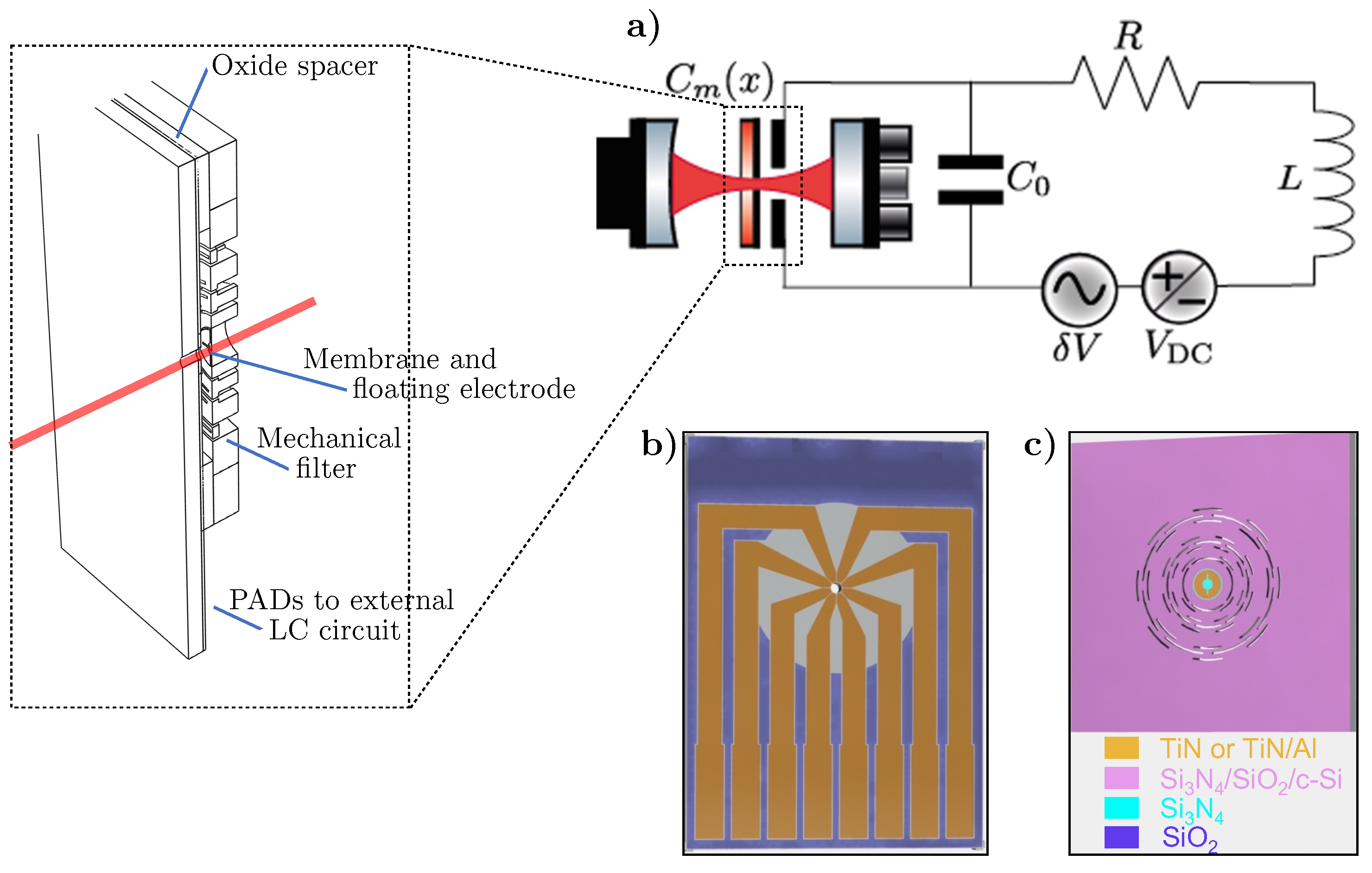
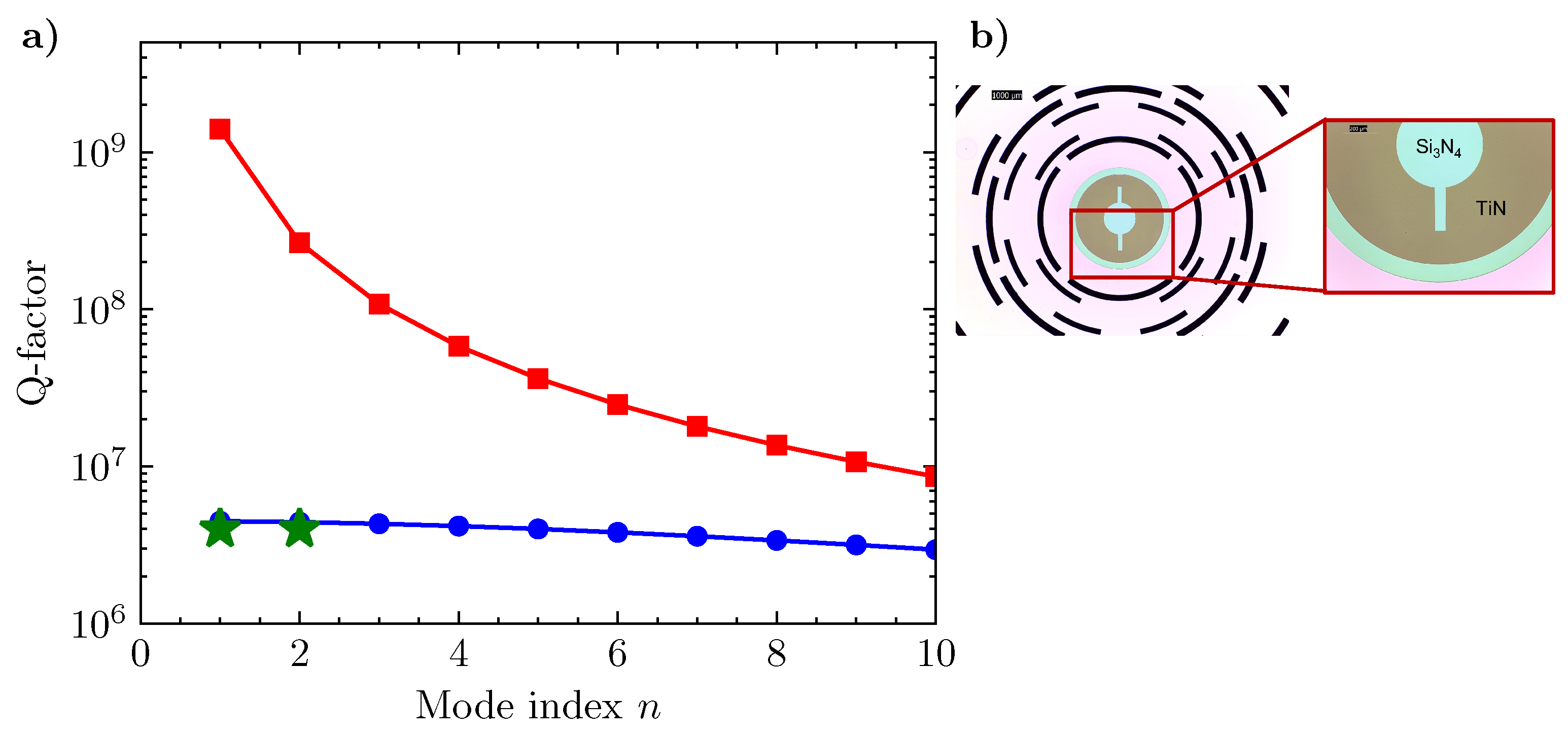

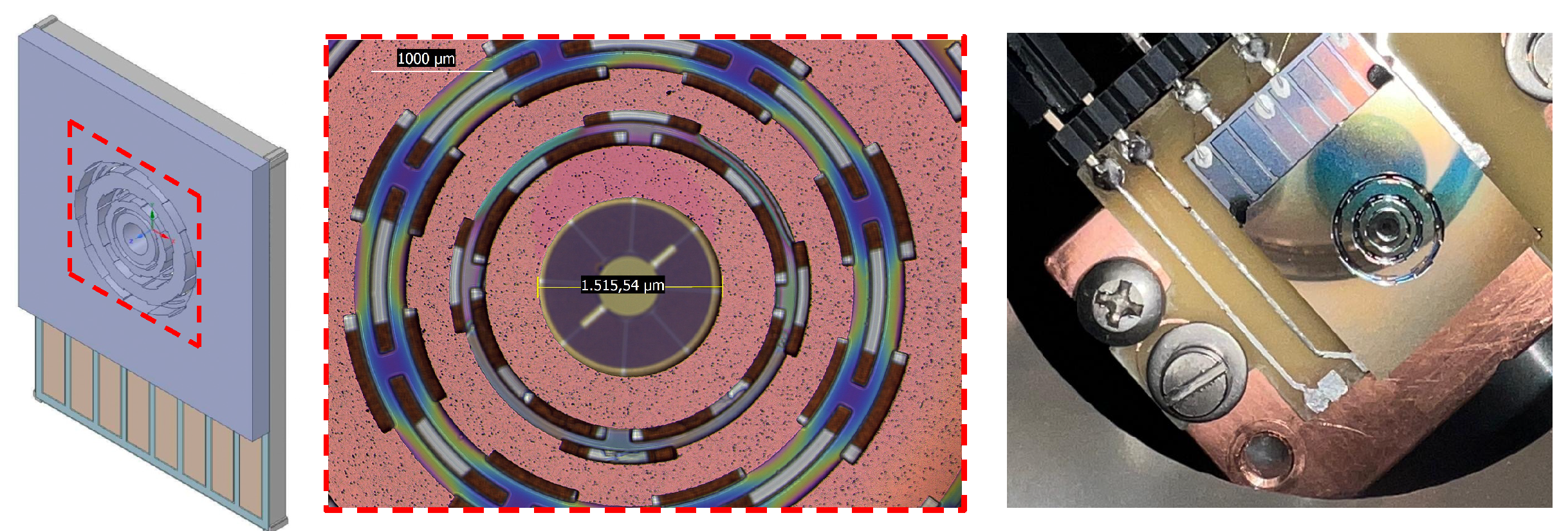

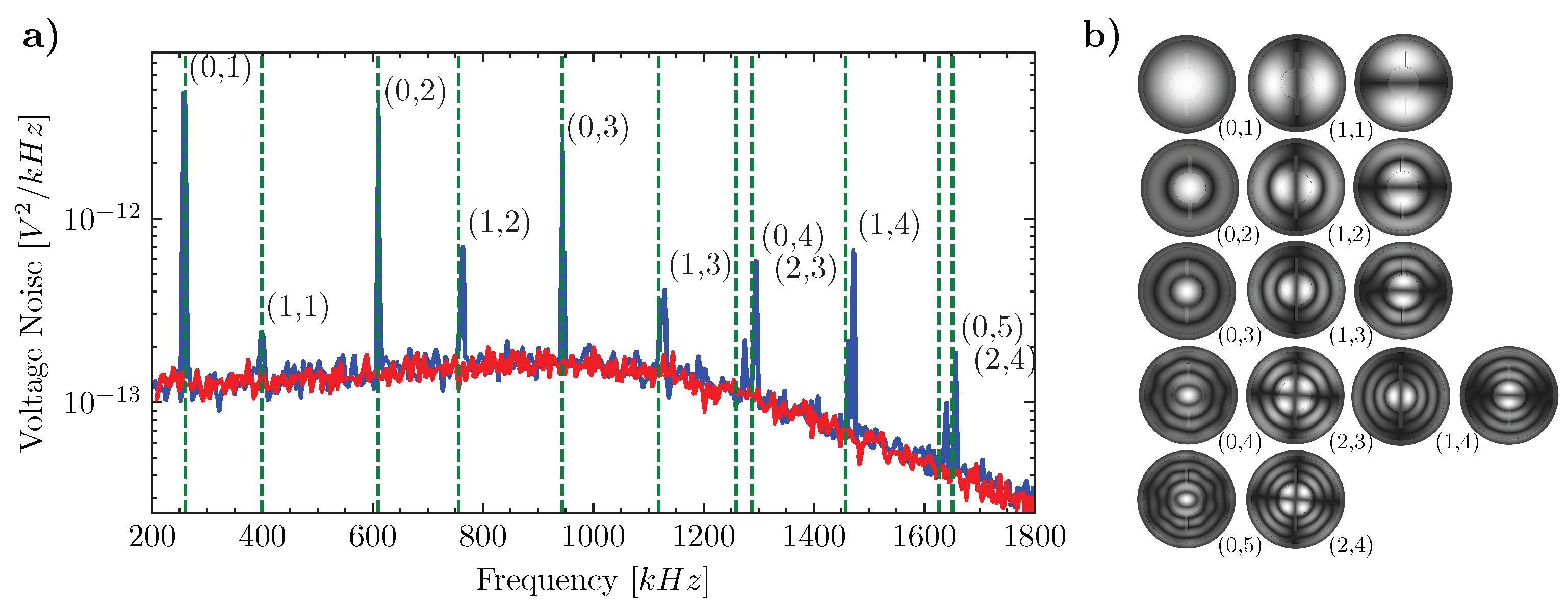
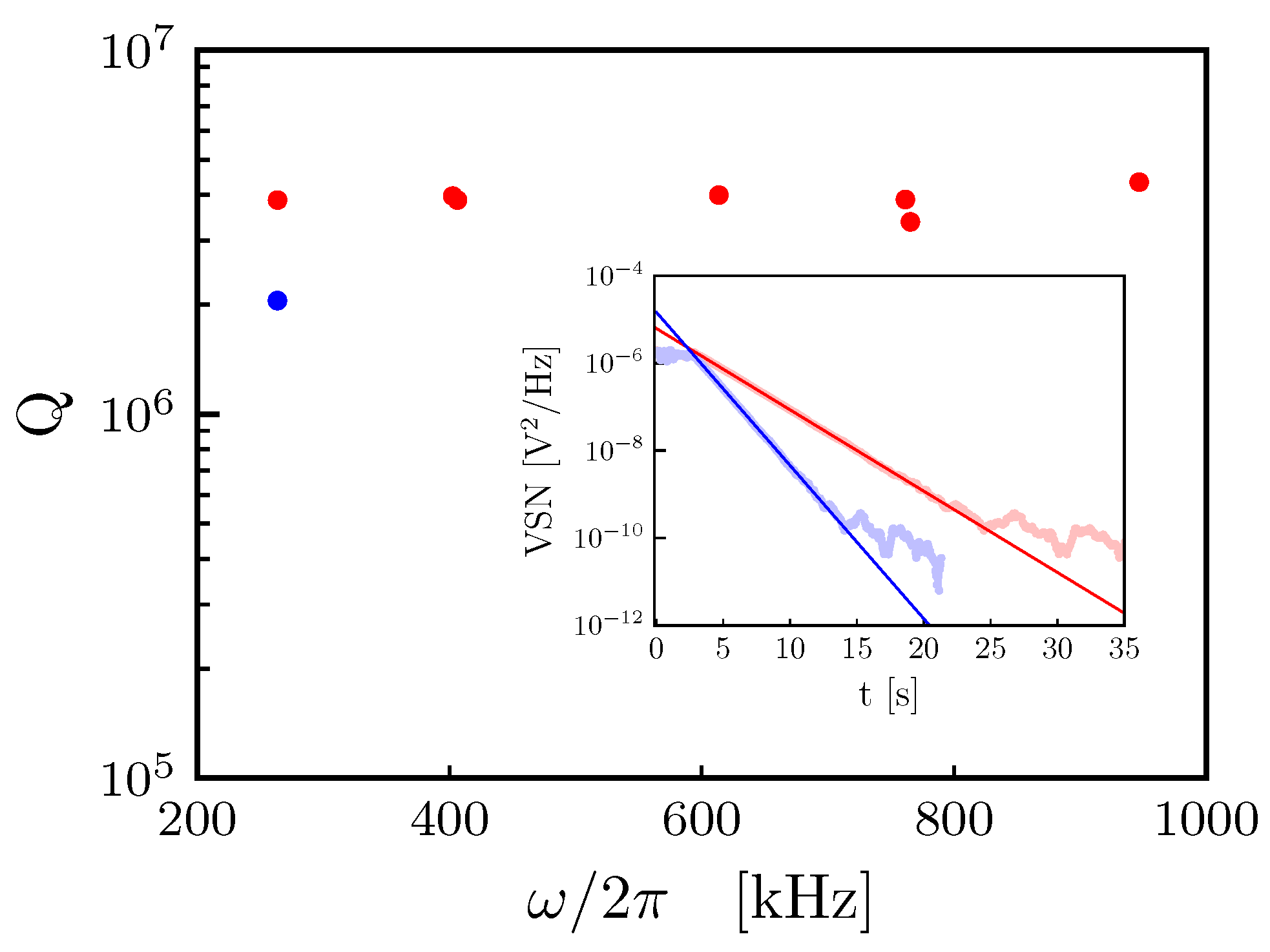
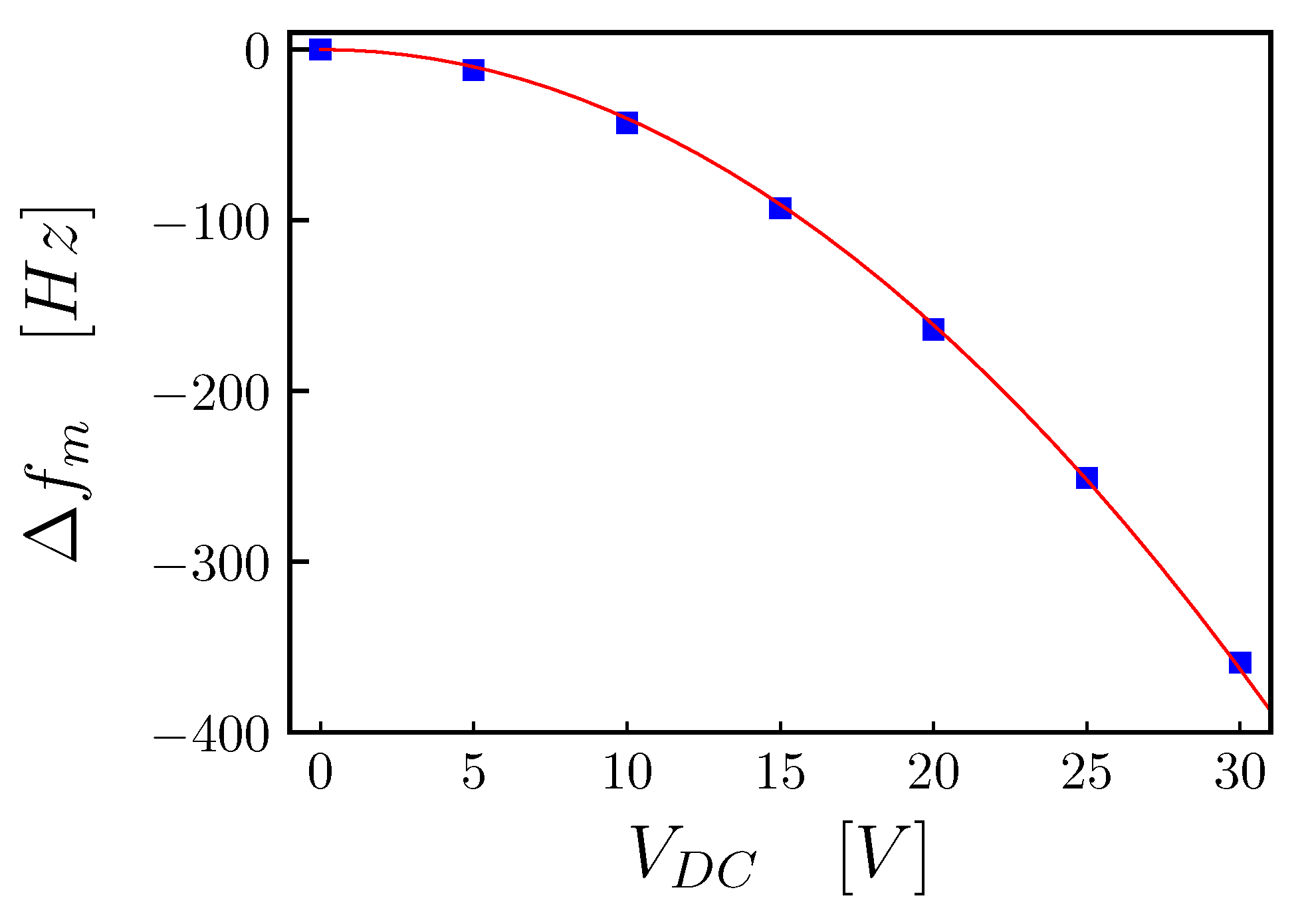
| SiN | TiN | |
|---|---|---|
| Y [GPa] | 270 | 600 |
| 0.27 | 0.27 | |
| 2700 | - | |
| h [nm] | 100 | 50 |
| R [m] | 740 | - |
| [m] | - | 250 |
| Mode Index | [kHz] | [kHz] | |
|---|---|---|---|
| (0,1) | 260.645 | 258.786 | 0.718 |
| (1,1) | 398.802 | 399.587 | 0.196 |
| (0,2) | 609.854 | 611.659 | 0.295 |
| (1,2) | 755.813 | 764.629 | 1.153 |
| (0,3) | 943.985 | 943.094 | 0.094 |
| (1,3) | 1118.259 | 1129.09 | 0.959 |
| (0,4) | 1258.374 | 1296.55 | 2.944 |
| (2,3) | 1288.075 | 1275.69 | 0.971 |
| (1,4) | 1457.844 | 1471.24 | 0.910 |
| (0,5) | 1626.986 | 1640.15 | 0.802 |
| (2,4) | 1651.324 | 1658.11 | 0.409 |
Disclaimer/Publisher’s Note: The statements, opinions and data contained in all publications are solely those of the individual author(s) and contributor(s) and not of MDPI and/or the editor(s). MDPI and/or the editor(s) disclaim responsibility for any injury to people or property resulting from any ideas, methods, instructions or products referred to in the content. |
© 2023 by the authors. Licensee MDPI, Basel, Switzerland. This article is an open access article distributed under the terms and conditions of the Creative Commons Attribution (CC BY) license (https://creativecommons.org/licenses/by/4.0/).
Share and Cite
Bonaldi, M.; Borrielli, A.; Di Giuseppe, G.; Malossi, N.; Morana, B.; Natali, R.; Piergentili, P.; Sarro, P.M.; Serra, E.; Vitali, D. Low Noise Opto-Electro-Mechanical Modulator for RF-to-Optical Transduction in Quantum Communications. Entropy 2023, 25, 1087. https://doi.org/10.3390/e25071087
Bonaldi M, Borrielli A, Di Giuseppe G, Malossi N, Morana B, Natali R, Piergentili P, Sarro PM, Serra E, Vitali D. Low Noise Opto-Electro-Mechanical Modulator for RF-to-Optical Transduction in Quantum Communications. Entropy. 2023; 25(7):1087. https://doi.org/10.3390/e25071087
Chicago/Turabian StyleBonaldi, Michele, Antonio Borrielli, Giovanni Di Giuseppe, Nicola Malossi, Bruno Morana, Riccardo Natali, Paolo Piergentili, Pasqualina Maria Sarro, Enrico Serra, and David Vitali. 2023. "Low Noise Opto-Electro-Mechanical Modulator for RF-to-Optical Transduction in Quantum Communications" Entropy 25, no. 7: 1087. https://doi.org/10.3390/e25071087
APA StyleBonaldi, M., Borrielli, A., Di Giuseppe, G., Malossi, N., Morana, B., Natali, R., Piergentili, P., Sarro, P. M., Serra, E., & Vitali, D. (2023). Low Noise Opto-Electro-Mechanical Modulator for RF-to-Optical Transduction in Quantum Communications. Entropy, 25(7), 1087. https://doi.org/10.3390/e25071087








